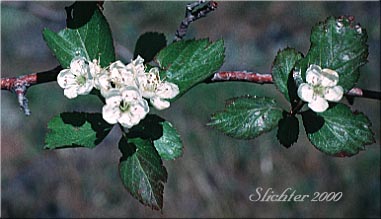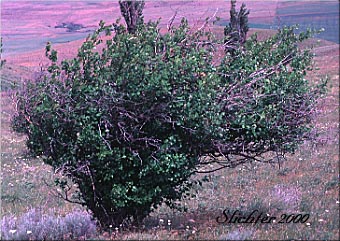Black hawthorn is a deciduous shrub or small tree from 1-12 meters high. The bark is rough and scaly with gray coloration on the older branches and the younger branches a dark reddish brown The thorns are 12-25 mm long. The leaves alternate on the branches, and they are simple with pinnate venation. The leaves are 25-75 mm long, broadly obovate in shape, and with double toothed margins.
The numerous flowers are in flat-topped clusters or corymbs. The individual flowrs are about 15 mm wide with 5 white, orbicular petals. The sepals are short and triangular. Typically there are 10 stamens, each with pink anthers. There are 4-5 styles. The fruit are black and smooth surfaced, and this is what gives this hawthorn its common name.
This species is similar to Suksdorf's hawthorn (Crataegus suksdorfii). Although leaf shape is commonly used, this may be unreliable. The preferred characteristic used for differentiation is the number of stamens as well as the color of the young branches.
Black hawthorn is found in meadows, on dry hillsides, and in riparian areas.
Black hawthorn may be found from southern British Columbia south along the eastern edge of the Cascades to California. It may be found eastward to Alberta and south Wyoming. It may also be found in the Puget Trough.
In the Columbia River Gorge, it may be found between the elevations of 100'-1900' from east of Cape Horn to the Columbia Hills in the east.

